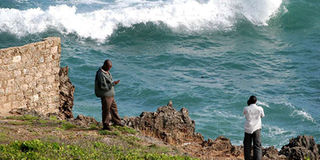Rising sea level slowly drowning coastal beaches

High tides witnessed in the Indian Ocean. Scientists say rising sea level does more harm than good.
What you need to know:
- The National Museums of Kenya raised an alarm that Fort Jesus, a recognised heritage site, is being washed away by sea waves.
- Kenya Marine and Fisheries Research Institute says the country should adapt to the changing sea levels.
It is a few minutes past six in the evening and the thuds of the Indian Ocean waves are drowning the blissful screams and giggles of children swimming by the shore at Kenyatta public beach in Mombasa. In the backdrop, two ships head for the Kilindini harbour.
Under the shade of a temporary structure, Mr Juma Mkunge lies idly surrounded by beach swimwear, floaters and a mountain bike that has seen better days.
“Do you want a floater?” he asks, as he points to several on display.
I decline politely, telling him the water is close to the shore, and the waves are getting stronger.
“Yeah that’s true. These days we are out of here by 7pm because the water comes in early,” Mr Mkunge says.
LIFESTYLE
In under half an hour as we talk about his business, and the beach life, the beach has emptied, with many of the swimmers now out of the ocean, while some beach boys warn those attempting to swim against the waves.
“This is our life now,” Mr Mkunge says, pointing at the emptying beaches. “We used to play beach volleyball, but that is a rarity these days, as even before dusk, the water is already ashore. I have been here since the early nineties and it was different. Then, we would spend the evening in the water till the moon comes up. It isn’t the case anymore.”
This is the new reality of coastal residents, as the rising sea levels alter their lifestyles, threatening the very core of their livelihoods.
From fortified beach fronts using sand bags, to hotels and private residences constructing sea walls, the reality is fast sinking in.
Over the years, the story is slowly changing along the country’s coastline, with the beachfronts slowly thinning.
TOURISM
This could potentially mean no more beaches and hotels, leading to a decline in tourism - a lifeline for many coastal communities.
“We are now seeing very serious changes in the ocean tide. Previously, it wasn’t getting to my fence, but now the tidal wave is,” Mr Sebastian Lamber says from his home that borders Mtwapa Creek in Kilifi.
At the start of last year, the National Museums of Kenya (NMK) raised an alarm that Fort Jesus, a recognised Unesco World Heritage site, is being washed away by rising sea waves.
Then they started a project to fortify part of it with a sea wall. About 80 per cent of this work is already complete, as they race to protect the site from the vengeance of the ocean waters, slowly chipping away its coral-stoned walls.
VULNERABLE
Ms Fatma Twahir, the principal curator at Fort Jesus, says a sea wall was proposed to prevent further erosion of the walls, and climate change is to blame.
“Fort Jesus is located on a coral ridge, north east of Mombasa Island, overlooking the entrance to the old Port of Mombasa. We are now undertaking a long-term solution by building a sea protection wall that would arrest the destruction,” Ms Twahir said.
According to a 2010 report by UN Habitat, sandy beaches and other features - including historical and cultural monuments such as Fort Jesus, several beach hotels, industries, the ship docking ports and human settlements - could be negatively affected by rising sea levels.
“Mombasa’s high level of vulnerability results from its low altitude, especially the coastal plain covering four to six kilometres wide and lying between sea level and about 45 metres above sea level. This low-lying area is likely to submerge should the sea levels rise,” the report said.
SANDBAGS
Owners of property along the Kenyan coastline have started investing in new methods to safeguard their buildings. Several hotels in Diani put sandbags on their beachfronts during high tides season.
“This is all about climate change and very high tides. We have had to fortify our frontage at the Diani Reef, as the tides have taken away all the sand. It does happen and eventually the tides will return the sand,” Diani Reef Hotel Managing Director Bobby Kamani said.
Ms Whitney Kihara, an assistant manager at Simba and Oryx Beach Cottages, also in Diani, said the water hits a small ‘hill’ near their beachfront during high tides.
UNINHABITABLE
According to the Intergovernmental Panel on Climate Change (IPCC) predictions report released in 2013, Mombasa and other parts of the East African coast could sink by 2080 as a result of rising water levels.
“It is estimated that about 17 per cent of Mombasa will be submerged with a sea-level rise of only 0.3 metres. At the same time, large areas may be rendered uninhabitable as a result of flooding or water logging, or will be agriculturally unsuitable due to salt stress,” the report said.
But it is not all doom and gloom. Kenya Marine and Fisheries Research Institute Chief Scientist James Kairo says something could be done, with several options available for the country to adapt to the changing sea levels, including using mangroves to protect the shoreline.





